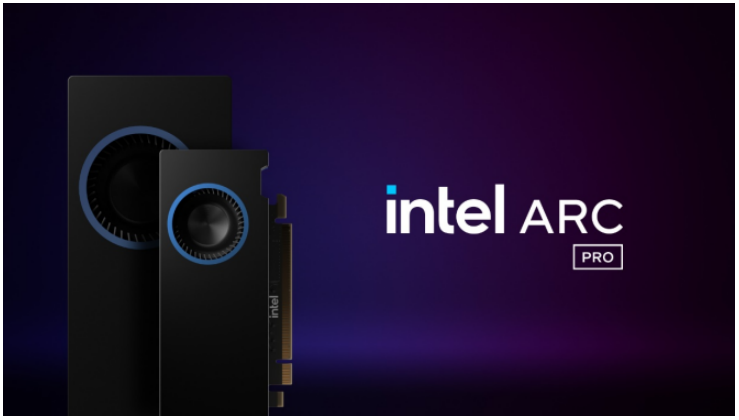Intel Announces New GPUs, New Options for AI and Workstations
2025-05-21 15:39:56 1129
BEIJING, May 19, 2025 - Today at Computex 2025, Intel announced a new lineup of graphics processors (GPUs) and AI gas pedals designed for professionals and developers. Included:
- New Intel Riptide™ Pro B-Series GPUs: the Intel Riptide Pro B60 and Intel Riptide Pro B50 GPUs, featuring configurations tailored for AI inference and professional workstations, expanding the Intel Riptide Pro product family.
- Intel® Gaudi 3 AI Accelerator: The Intel Gaudi 3 AI Accelerator is now available in both PCIe and rack-level system deployment options, providing a scalable and open solution for enterprise and cloud AI inference.
- Intel® AI Assistant Builder: The Intel AI Assistant Builder is now available on GitHub and can be used by developers to create native AI agents optimized for Intel platforms for specific purposes.
Leveraging Computex as an opportunity to continue to strengthen Intel's commitment to our partners and build a new Intel for the future,” said Lip-Bu Tan, CEO of Intel. Together, we will build exceptional products to meet customer needs and capitalize on future opportunities.”
New Intel GPUs for AI and workstation performance needs

Figure. 1
The new Intel Riptide Pro B60 and B50 GPUs are based on the Xe2 architecture with Intel XMX AI cores and advanced ray-tracing units to deliver powerful performance for creators, developers and engineers.
The launch of the new products enriches Intel's professional-grade GPU lineup. Intel Riptide Pro B60 and Intel Riptide Pro B50 GPUs, designed for demanding AI inference workloads and workstation applications. With AI features, 24GB and 16GB of graphics memory, respectively, and support for multi-GPU scaling, the Intel Riptide Pro B-Series offers diverse solutions for creators, AI developers and professionals.
Both GPUs are optimized for AEC (Architecture, Engineering, Construction) and inference workstations, and offer stable and reliable performance with a wide range of ISV certifications and optimized software. Intel Riptide Pro B-Series GPUs are compatible with consumer and professional drivers on Windows and support a containerized software stack on Linux that simplifies AI deployment and supports progressive upgrades and feature optimization. By combining high graphics memory capacity with critical software compatibility, the Intel Riptide Pro B-Series provides creators and AI developers with a scalable, cost-effective solution. Intel also announced a configurable workstation-class Intel® Xeon® platform (codenamed Project Battlematrix) to help AI developers solve the challenges they face. With up to 192GB of video random access memory (VRAM), it supports up to eight Intel Riptide Pro B60 24GB GPUs running medium-sized, highly accurate AI models with up to 150 billion parameters.

Figure. 2
The launch of the Intel Riptide Pro B-Series demonstrates Intel's persistence and commitment to GPU technology and ecology,” said Vivian Lien, vice president and general manager, Client Graphics, Intel. With the advanced performance of the Xe 2 architecture and a growing software ecosystem, the new Intel Riptide Pro GPUs provide easy-to-access and scalable solutions for small and medium-sized businesses that are always looking for targeted solutions.”
AIB partners, including but not limited to ASRock, Bluestreak, Lanner, Maxthon, AoS, Senao, and Shake & Tech, will begin sampling the Intel Riptide Pro B60 GPUs in June 2025. Intel Riptide Pro B50 GPUs will be available starting in July 2025 at Intel Authorized Resellers.
Intel Gaudi 3 Supports PCIe and Rack-Level Deployments
Intel furthered its AI strategy with the introduction of new deployment options for Intel Gaudi 3 AI gas pedals:
- The Intel Gaudi 3 PCIe card supports scalable AI inference in existing server data center environments. In the case of the AI big model LLaMa, for example, thanks to the scalable configuration, there is flexibility to run AI models of all sizes from LLaMA 3.1 8B to LLaMA 4 Scout or Maverick, regardless of the size of the organization. The Intel Gaudi 3 PCIe card is expected to be available in the second half of 2025.
- The Intel Gaudi 3 rack-level system reference design brings great flexibility and scalability with up to 64 gas pedals per rack and up to 8.2TB of high-bandwidth memory. The open modular design breaks down vendor constraints, while wired backplanes and blind-plug 2D full rack cabling make installation and maintenance easy. With liquid cooling, these systems deliver powerful performance and help keep TCO in check.
Deeply optimized for large AI models, the Intel Gaudi rack-level architectures enable superior real-time inference performance with low latency. These configurations support the customization needs of cloud service providers (CSPs) and the Open Compute Project (OCP) design specifications, further underscoring Intel's strong commitment to building an open, flexible and secure AI infrastructure.
Intel AI Assistant Builder now open for use
After debuting at CES 2025, Intel AI Assistant Builder is now available in public beta on GitHub. This lightweight, open software framework is designed for building and running custom AI agents locally on Intel AI-based PCs. The power of AI Assistant Builder is well demonstrated by the innovative solutions showcased by Acer and ASUS at Computex. Developers and partners can leverage the tool to quickly build and deploy AI agents for their organizations and customers to create more business value.
At Computex 2025, Intel showcased its latest processors and graphics cards, among other products.




